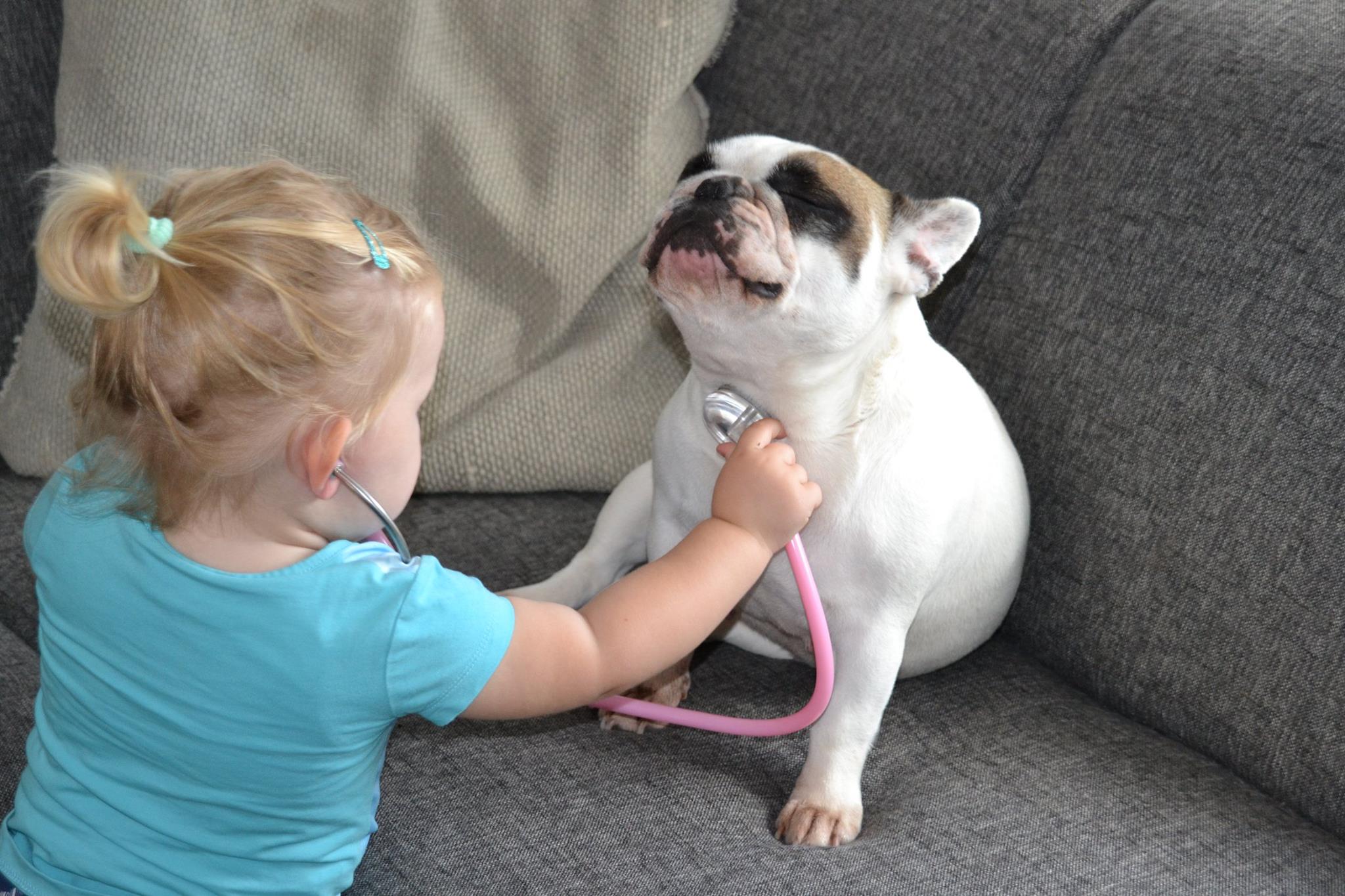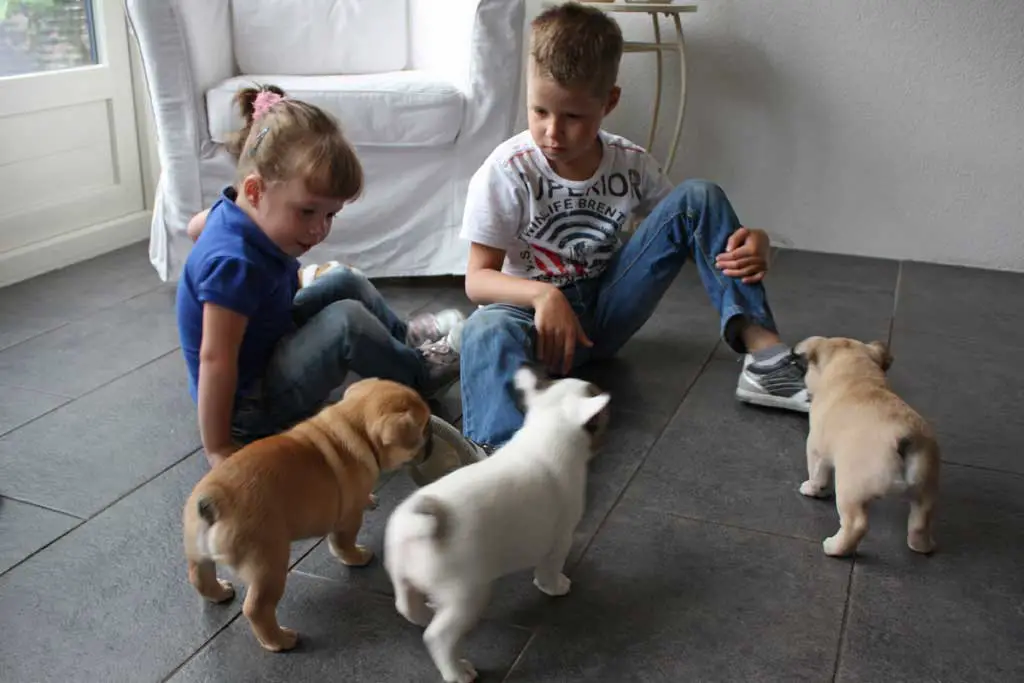A French Bulldog and kids, do they get along? The short answer is YES; they are great with kids. Although there is no greater child friend than the French bulldog, there are always Frenchies that have problems with kids or kids who have problems with Frenchies.
Kids and Frenchies
Endearing right? Children and dogs can be each other’s best friends.

And there are also scientific indications that having and caring for a pet is very good for the development of a child.
But…
Children are also often the victims of dog bites.
Of all the people who are admitted to the hospital due to a dog bite, 43% are younger than 10 years. Let that sink in for a moment; almost half of all dog bite incidents are kids…
Children are often so fond of dogs that they do exactly the things that a dog doesn’t really like.
Suddenly stroking, hanging around his neck, pulling his tail, taking toys… All fun activities for an enterprising toddler, which, however, are not particularly appreciated by most dogs, also for Frenchies because they have sensitive ears and a bad back.
A dog that, in turn, growls (completely logically) as a warning is not understood by the child.
A child cannot secure himself, and, moreover, a child is very vulnerable.
Their head is exactly at the height of a dog’s mouth, so if the dog bites unexpectedly, it is usually bad.
Children must learn that a dog (or any other animal) is not a toy.
With a few rules for a good relationship between child and dog, they can still enjoy each other a lot.
French Bulldogs and kids.
Make sure your Frenchie likes the child.

Children have to learn to deal with dogs, but dogs also have to learn that a child in the house (for example, a newborn baby) is part of the family.
When your French Bulldog is systematically excluded when the baby is being fed or is turned down when he is sniffing at the child, he will soon start to associate the phenomenon of ‘a child’ with a bad experience or negative feelings.
Dogs can learn that children are fun. We need to include our Frenchie and make him feel involved and wanted. A French Bulldog and kids go very well together; they just need to be used to each other.
Here are some do’s and don’ts that you must remember when you have a Frenchie, and there is a child on the way or when you buy a French Bulldog puppy and bring him into your family:
DON’T
Send your Frenchie away when the child gets attention, Grumbling.
Yell or shout at your Frenchie when he shows an interest in a child.
DO
Give your Frenchie attention or treats in the presence of the child.
Let the dog make a connection between ‘child’ and ‘nice’,
For example, by giving him something tasty every time you start feeding or changing your baby or by taking him out when you go on a walk with your child.
Give your Frenchie its own safe place during pregnancy, and learn him to stay quiet and stay there on command, preferably with a nice treat or toy.
Teach the child to respect your Frenchie
Dogs have been living with people for years, but their behavior is partly determined by primeval instincts.
Food and a safe place to call home are so important for survival that a dog will do everything to get and keep it.
Children have no idea of this and sometimes put their heads in the food bowl or crawl in his basket to wish him goodnight.
Fortunately, there are a lot of dogs who don’t care about this, but there are also plenty who find this type of activity very threatening. Lucky for us Frenchie owners, a French Bulldog isn’t one of the latter. That’s why a French Bulldog and kids are a perfect fit
The more aggressive breeds have no other choice but to growl as a warning, and if that doesn’t help, they will bite 😦. Again here are some do’s and don’ts
DON’T
Let the child walk or crawl towards your Frenchie, certainly not when he is in his basket.
Have the child bother your Frenchie when he is eating, or playing with a toy, etc.
Let your child(ren) shout loudly and run in a very wild manner near your Frenchie.
Have children crawl on the floor next to him.
DO
Let your Frenchie come to the child to do something fun or play.
Let the (slightly older) child feed the dog a treat by hand unless the dog is very tense while eating.
Have children play with the dog, for example, a search game, where the child can hide a toy that the dog must look for. Both think it is great, for the dog it is not threatening, and the child and dog get a better bond.
Don’t let a child challenge or command the dog.
A dog sees his family as a pack in which there is a fixed order. He sees the adults in the family as pack leaders.
It is simply not possible to teach a child to be the boss of a dog.
A child is physically and psychologically unable to force a dog into a “lower” position.
Dogs are usually well aware of this; they will, therefore, regard the child as being placed lower in the pack.

Children and strange dogs
A quarter of all biting accidents are caused by strange dogs.
That is not a reason to make a child afraid of dogs, but do teach a child here what can and cannot be done.
Dog owners are responsible for the proper education of their dogs.
Just as with traffic, children must also learn rules for dealing with strange dogs on the street.
You can like dogs or not, but you will always run into them on the street, in the park…
Fortunately, there are a lot of nice and friendly dogs.
But the dogs you meet on the street are not all nice (just like people), and there are still too many parents who let their children pet every dog they encounter.
They think that they are doing their child a favor but do not realize that a dog has its own opinion about this.
Here are some do’s and don’ts when your child encounters strange dogs on the street or in the park… Kids think that when they have a nice and loving Frenchie at home that every dog they meet is like that.
DON’T
Let the child stare at the dog (this threatens a dog)
Let your kid hang over the dog’s neck. (this might seem obvious, but lots of parents let their kids do this)
Let the child give the dog instructions.
DO
The child learns, along with the dog, to look around.
Taking the dog and the children together for a nice walk.
Ensuring a fun game between child and dog.
Misconceptions that people say about dogs:
“He looks so sweet”
Any dog can bite, whether he’s large or small, black or white, with or without a tail…
A large dangerous-looking dog can be a big teddy bear, a small cuddly dog can be very nasty, and vice versa.
In addition, even the sweetest, nicest dog can be scared of a child or just don’t want to be touched.
I bet that you probably wouldn’t like to be touched on the street by a total stranger.
“Oh, He wags his tail”
The biggest misunderstanding in the world is that a dog that wags is always happy.
Wagging looks very cute but can mean different things, such as
: “Hello, how nice that I see you” or
: “beware, this is my area, I am the boss here, do you see that?”
but also, “how scary you are, please leave soon!”
“We have a dog ourselves”
Many people think that another dog will not bite their child because they also have a dog at home.
The dog that is waiting for his boss at the supermarket isn’t always a friendly one.
Maybe that dog doesn’t want to be petted, or maybe he even finds children scary.
The fact that the child may not be afraid itself does not change that.
DON’T
Let your kid pet a strange dog.
Scare a child for dogs.
Let the child scream or run away when a dog arrives (the harder it screams or runs, the more interesting a dog will find the child, that’s his hunting instinct)
The child hit the dog.
DO
Teach your child three rules for petting dogs:
- First, ask your mother or father
(and if there is no mom or dad around: do not pet!!)
- Then ask the dog’s owner
(and if there is no owner: do not pet!)
- If you are allowed to pet the dog by both the parents and the owner: carefully extend your hand and see if the dog comes to you.
when he doesn’t come, he doesn’t feel like it and you have to leave him alone.
If he does come, gently tickle him UNDER his chin or on his back.
Don’t stroke him upside down, most dogs don’t like it at all.
Teach a child how to deal with dogs.
Also, teach a (scared) child to stand still quietly when a dog arrives and look the other way.
Remind your kid to keep his hands in his pocket or on his back.
(most dogs know from experience that there is often something yummy in the hands, so they will look for it. With hands on the back, a dog may smell it for a while but quickly lose interest)
And the last but most important tip of all:
Let children and dogs NEVER, EVER, EVER alone with each other!!!
Apply the tips above, and you’ll see that a French Bulldog and your kids will be friends for life.
